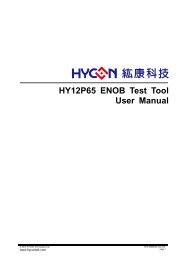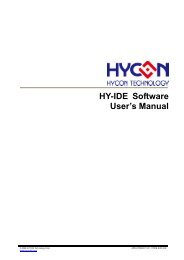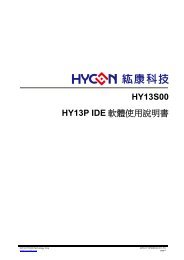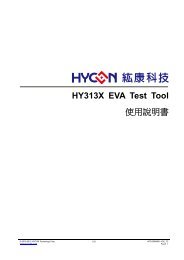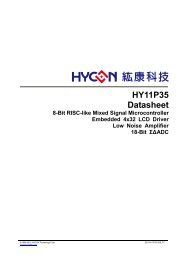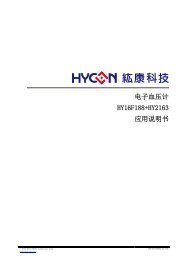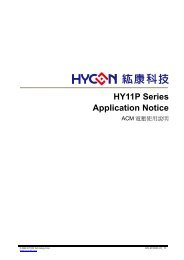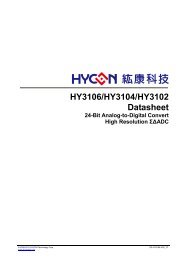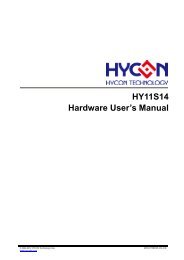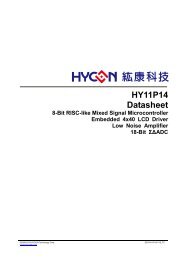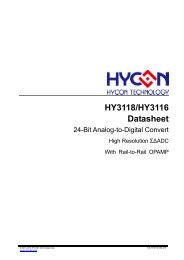HY2112 Datasheet
HY2112 Datasheet
HY2112 Datasheet
You also want an ePaper? Increase the reach of your titles
YUMPU automatically turns print PDFs into web optimized ePapers that Google loves.
© 2009-2011 HYCON Technology Corp.<br />
www.hycontek.com<br />
.<br />
<strong>HY2112</strong><br />
<strong>Datasheet</strong><br />
1- Cell LiFePO4<br />
Battery Packs Protection ICs<br />
DS-<strong>HY2112</strong>-V05_EN
<strong>HY2112</strong><br />
1-Cell LiFePO4 Battery Packs Protection ICs<br />
© 2009-2011 HYCON Technology Corp<br />
www.hycontek.com<br />
Table of Contents<br />
1. GENERAL DESCRIPTION ....................................................................................................................... 4<br />
2. FEATURES ............................................................................................................................................... 4<br />
3. APPLICATIONS ........................................................................................................................................ 4<br />
4. BLOCK DIAGRAM ................................................................................................................................... 5<br />
5. ORDERING INFORMATION.....................................................................................................................<br />
6<br />
6. MODEL LIST.............................................................................................................................................<br />
6<br />
7. PIN CONFIGURATION AND PACKAGE MARKING INFORMATION ..................................................... 7<br />
8. ABSOLUTE MAXIMUM RATINGS ........................................................................................................... 7<br />
9. ELECTRICAL CHARACTERISTICS ........................................................................................................ 8<br />
10. BATTERY PROTECTION IC CONNECTION EXAMPLE.........................................................................<br />
9<br />
11. DESCRIPTION OF OPERATION............................................................................................................<br />
10<br />
11.1 Normal Status......................................................................................................................................<br />
10<br />
11.2 Overcharge Status .............................................................................................................................. 10<br />
11.3 Overdischarge Status and Sleep Mode .............................................................................................. 11<br />
11.4 Discharge Overcurrent Status (Discharge Overcurrent & Short Circuit) ............................................. 11<br />
11.5 Charge Overcurrent Status ................................................................................................................. 12<br />
11.6 0V Battery Charging Function “Available” ........................................................................................... 12<br />
.<br />
11.7 0V Battery Charging Function “Unavailable” ...................................................................................... 12<br />
12. PACKAGE INFORMATION.....................................................................................................................<br />
14<br />
12.1. SOT-23-6.............................................................................................................................................<br />
14<br />
13. REVISION RECORD...............................................................................................................................<br />
15<br />
DS-<strong>HY2112</strong>-V05_EN<br />
page2
<strong>HY2112</strong><br />
1-Cell LiFePO4 Battery Packs Protection ICs<br />
Attention:<br />
1. HYCON Technology Corp. reserves the right to change the content of this datasheet without further<br />
notice. For most up-to-date information, please constantly visit our website:<br />
http://www.hycontek.com .<br />
2. HYCON Technology Corp. is not responsible for problems caused by figures or application circuits<br />
narrated herein whose related industrial properties belong to third parties.<br />
3. Specifications of any HYCON Technology Corp. products detailed or contained herein stipulate the<br />
performance, characteristics, and functions of the specified products in the independent state. We<br />
does not guarantee of the performance, characteristics, and functions of the specified products as<br />
placed in the customer’s products or equipment. Constant and sufficient verification and evaluation<br />
is highly advised.<br />
4. Please note the operating conditions of input voltage, output voltage and load current and ensure<br />
the IC internal power consumption does not exceed that of package tolerance. HYCON Technology<br />
Corp. assumes no responsibility for equipment failures that resulted from using products at values<br />
that exceed, even momentarily, rated values listed in products specifications of HYCON products<br />
specified herein.<br />
5. Notwithstanding this product has built-in ESD protection circuit, please do not exert excessive static<br />
electricity to protection circuit.<br />
.<br />
6. Products specified or contained herein cannot be employed in applications which require extremely<br />
high levels of reliability, such as device or equipment affecting the human body, health/medical<br />
equipments, security systems, or any apparatus installed in aircrafts and other vehicles.<br />
7. Despite the fact that HYCON Technology Corp. endeavors to enhance product quality as well as<br />
reliability in every possible way, failure or malfunction of semiconductor products may happen.<br />
Hence, users are strongly recommended to comply with safety design including redundancy and<br />
fire-precaution equipments to prevent any accidents and fires that may follow.<br />
8. Use of the information described herein for other purposes and/or reproduction or copying without<br />
the permission of HYCON Technology Corp. is strictly prohibited.<br />
© 2009-2011 HYCON Technology Corp<br />
www.hycontek.com<br />
DS-<strong>HY2112</strong>-V05_EN<br />
page3
<strong>HY2112</strong><br />
1-Cell LiFePO4 Battery Packs Protection ICs<br />
1. General Description<br />
The series of <strong>HY2112</strong> ICs is best created for single-cell LiFePO4 rechargeable battery<br />
protection and it also comprises high-accuracy voltage detectors and delay circuits.<br />
These ICs are suitable for protecting single-cell rechargeable LiFePO4 battery packs<br />
against the problems of overcharge, overdischarge and overcurrent.<br />
2. Features<br />
The features that whole series of <strong>HY2112</strong> comprised are as follows:<br />
(1) High-accuracy voltage detection circuit<br />
● Overcharge detection voltage 3.600 to 4.000V Accuracy:±25mV<br />
● Overcharge release voltage 3.400 to 4.000V Accuracy:±50mV<br />
● Overdischarge detection voltage 1.8 to 2.2V Accuracy:±50mV<br />
● Overdischarge release voltage 1.8 to 2.4V Accuracy:±50mV<br />
● Discharge overcurrent detection voltage (by option) Accuracy:±15mV<br />
● Charge overcurrent detection voltage (by option) Accuracy:±15mV<br />
● Short-circuiting detection voltage 0.85V (fixed) Accuracy ±300mV<br />
(2)Delay times are generated by an internal circuit (external capacitors are unnecessary).<br />
● Overcharge delay time 1200ms typ.<br />
● Overdischarge delay time .<br />
140ms typ.<br />
● Discharge overcurrent delay time 12ms typ.<br />
● Charge overcurrent delay time 8ms typ.<br />
● Short circuit delay time 300μs typ.<br />
(3) Low current consumption<br />
● Operation mode 3.0μA typ., 6.0μA max. (VDD=3.2V)<br />
● Ultra low power-down current at 0.1μA max.<br />
(4) High-withstanding-voltage device is used for charger connection pins<br />
(CS pin and OC pin : Absolute maximum rating = 20 V)<br />
(5) 0 V battery charge function “available” / “unavailable” are selectable(See Model List)<br />
(6) Wide operation temperature range −40°C to +85 °C<br />
(7) Small package SOT-23-6<br />
(8) The <strong>HY2112</strong> series are Halogen-free, green package<br />
3. Applications<br />
● 1-cell LiFePO4 rechargeable battery packs<br />
© 2009-2011 HYCON Technology Corp<br />
www.hycontek.com<br />
DS-<strong>HY2112</strong>-V05_EN<br />
page4
<strong>HY2112</strong><br />
1-Cell LiFePO4 Battery Packs Protection ICs<br />
4. Block Diagram<br />
© 2009-2011 HYCON Technology Corp<br />
www.hycontek.com<br />
.<br />
DS-<strong>HY2112</strong>-V05_EN<br />
page5
<strong>HY2112</strong><br />
1-Cell LiFePO4 Battery Packs Protection ICs<br />
5. Ordering Information<br />
� Product Name Define<br />
6. Model List<br />
Model<br />
Overcharge<br />
detection<br />
voltage<br />
© 2009-2011 HYCON Technology Corp<br />
www.hycontek.com<br />
Overcharge<br />
release<br />
voltage<br />
Overdischarge<br />
detection<br />
voltage<br />
Overdischarge<br />
release<br />
voltage<br />
Discharge<br />
overcurrent<br />
detection<br />
voltage<br />
Overcharge<br />
overcurrent<br />
detection<br />
voltage<br />
0V<br />
battery<br />
charge<br />
function<br />
VCU VCR VDL VDR VDIP VCIP V0CH<br />
<strong>HY2112</strong>-AB 3.75±0.025V 3.60±0.05V 2.1±0.05V 2.3±0.05V 100±15mV -50±15mV available<br />
<strong>HY2112</strong>-BB 3.75±0.025V 3.60±0.05V 2.1±0.05V 2.3±0.05V 150±15mV -50±15mV available<br />
<strong>HY2112</strong>-CB 3.75±0.025V 3.60±0.05V 2.1±0.05V 2.3±0.05V 200±15mV -50±15mV available<br />
<strong>HY2112</strong>-EB 3.90±0.025V 3.75±0.05V 2.1±0.05V 2.3±0.05V 200±15mV -50±15mV available<br />
<strong>HY2112</strong>-GB 3.75±0.025V 3.25±0.05V 1.825±0.05V 2.37±0.05V 100±15mV -100±15mV available<br />
Remark: Please contact our sales office for the products with detection voltage value other than those<br />
specified above.<br />
.<br />
DS-<strong>HY2112</strong>-V05_EN<br />
page6
<strong>HY2112</strong><br />
1-Cell LiFePO4 Battery Packs Protection ICs<br />
7. Pin Configuration and Package Marking Information<br />
Pin No. Symbol Description<br />
© 2009-2011 HYCON Technology Corp<br />
www.hycontek.com<br />
1 OD MOSFET gate connection pin for discharge control<br />
2 CS Input pin for current sense, charger detect pin<br />
3 OC MOSFET gate connection pin for charge control<br />
4 NC No connection.<br />
5 VDD Power supply pin<br />
6 VSS Ground pin<br />
8. Absolute Maximum Ratings<br />
(VSS=0V, Ta=25°C unless otherwise specified)<br />
12:Product Name<br />
XB:Serial code and Package name<br />
XXXX:Date code<br />
Item Symbol Rating Unit<br />
Input voltage between VDD and VSS pin VDD VSS-0.3 to VSS+10 V<br />
OC output pin voltage VOC VDD -20 to VDD +0.3 V<br />
OD output pin voltage VOD VSS-0.3 to VDD +0.3 V<br />
CS input pin voltage VCS VDD -20 to VDD +0.3 V<br />
Operating Temperature Range TOP -40 to +85 °C<br />
Storage Temperature Range TST -40 to +125 °C<br />
.<br />
Power dissipation PD 250 mW<br />
DS-<strong>HY2112</strong>-V05_EN<br />
page7
<strong>HY2112</strong><br />
1-Cell LiFePO4 Battery Packs Protection ICs<br />
9. Electrical Characteristics<br />
(Ta=25°C unless otherwise specified)<br />
© 2009-2011 HYCON Technology Corp<br />
www.hycontek.com<br />
Item Symbol Condition Min. Typ. Max. Unit<br />
Operating voltage between VDD<br />
pin and VSS pin<br />
VDSOP1<br />
SUPPLY POWER RANGE<br />
- 1.5 - 8 V<br />
Operating voltage between VDD<br />
pin and CS pin<br />
VDSOP2 -<br />
INPUT CURRENT<br />
1.5 - 20 V<br />
Supply Current IDD VDD=3.2V - 3.0 6.0 μA<br />
Power-Down Current IPD<br />
DETECTION VOLTAGE<br />
- - 0.1 μA<br />
Overcharge Detection Voltage VCU 3.6V to 4.0V adjustable<br />
VCU<br />
-0.025<br />
VCU<br />
VCU<br />
+0.025<br />
Overcharge Release Voltage VCR 3.4V to 4.0V adjustable VCR -0.05 VCR<br />
+0.05<br />
V<br />
Overdischarge Detection Voltage VDL 1.8V to2.2V adjustable VDL -0.05 VDL VDL +0.05 V<br />
Overdischarge Release Voltage VDR 1.8V to2.4V adjustable VDR<br />
-0.05 VDR<br />
VDR<br />
+0.05<br />
V<br />
Discharge Overcurrent Detection<br />
Voltage<br />
VDIP<br />
.<br />
VDIP -15 VDIP VDIP +15 mV<br />
Charge Overcurrent Detection<br />
Voltage<br />
V CIP VDIP -15 V DIP V DIP +15 mV<br />
Short Circuit Detection Voltage VSIP VDD=3.0V DELAY TIME<br />
0.55 0.85 1.15 V<br />
Overcharge Delay Time TOC 900 1200 1500 ms<br />
Overdischarge Delay Time T OD 105 140 175 ms<br />
Discharge Overcurrent Delay<br />
Time<br />
TDIP 9 12 15 ms<br />
charge Overcurrent Delay Time TCIP 6<br />
8 10 ms<br />
Short Circuit Delay Time TSIP VDD=3.0V 200 300 400 μs<br />
CONTRO L OUTPUT VOLTAGE(OD&OC)<br />
OD Pin Output “H” Voltage VDH VDD -0.1 VDD -0.02 - V<br />
OD Pin Output “L” Voltage VDL - 0.1 0.5 V<br />
OC Pin Output “H” Voltage VCH VDD -0.1 VDD -0.02 - V<br />
OC Pin Output “L” Voltage VCL - 0.1 0.5 V<br />
0V BATTERY CHARGE F UNCTION<br />
0V battery charge starting<br />
charger voltage<br />
V0CH<br />
0V battery charging<br />
function “available”<br />
1.2 - - V<br />
0V battery charge inhibition<br />
charger voltage<br />
V0IN<br />
0V battery charging<br />
function “unavailable”<br />
- - 0.5 V<br />
VCR<br />
V<br />
DS-<strong>HY2112</strong>-V05_EN<br />
page8
<strong>HY2112</strong><br />
1-Cell LiFePO4 Battery Packs Protection ICs<br />
10. Battery Protection IC Connection Example<br />
Symbol Device Name Purpose Min. Typ. Max. Remark<br />
R1 Resistor<br />
Limiting current, stabilize VDD<br />
and strengthen ESD protection<br />
100Ω 100Ω 470Ω *1<br />
R2 Resistor Limiting current 300Ω 2kΩ 2kΩ *2<br />
C1 Capacitor Stabilizing VDD 0.01μF 0.1μF 1.0μF *3<br />
M1<br />
M2<br />
N-MOSFET<br />
N-MOSFET<br />
Discharge control<br />
Charge control<br />
.<br />
-<br />
-<br />
-<br />
-<br />
-<br />
-<br />
*4<br />
*5<br />
*1. R1 should be as small as possible to avoid lowering the overcharge detection accuracy<br />
due to current consumption. When a charger is connected in reversed, the current flows<br />
from the charger to the IC. At this time, if R1 is connected to high resistance, the voltage<br />
between VDD pin and VSS pin may exceed the absolute maximum rating.<br />
*2. If R2 has a resistance higher than 2kΩ, the charging current may not be cut when a<br />
high-voltage charger is connected. Please select as large a resistance as possible to<br />
prevent current when a charger is connected in reversed.<br />
*3. C1 will stabilize the supply voltage of VDD,the value of C1 should be equal to or more<br />
than 0.01μF.<br />
*4. If a FET with a threshold voltage equal to or higher than the overdischarge detection<br />
voltage is applied, discharging may be stopped before overdischarge is detected.<br />
*5. If the withstanding voltage between the gate and source is lower than the charger<br />
voltage, the FET may be destroyed.<br />
Caution:<br />
(1) The above constants may be changed without notice,please download the most<br />
up-to-date datasheet on our website. http://www.hycontek.com<br />
(2) It is advised to perform thorough evaluation and test if peripheral devices need to be<br />
adjusted.<br />
© 2009-2011 HYCON Technology Corp<br />
www.hycontek.com<br />
DS-<strong>HY2112</strong>-V05_EN<br />
page9
<strong>HY2112</strong><br />
1-Cell LiFePO4 Battery Packs Protection ICs<br />
11. Description of Operation<br />
11.1 Normal Status<br />
This IC monitors the voltage of the battery connected between the VDD pin and VSS pin<br />
and the voltage difference between the CS pin and VSS pin to control charging and<br />
discharging.<br />
For ICs that equipped with discharge overcurrent detection voltage (VDIP), when battery<br />
voltage is above overdischarge detection voltage (VDL) and under overcharge detection<br />
voltage (VCU) and CS pin voltage is under discharge overcurrent detection voltage (VDIP),<br />
the OD and OC pin will output high potential difference, to turn both charging and<br />
discharging control MOSFET on. This condition is called “Normal Status”. Under this<br />
condition, charging and discharging can both be carried out freely.<br />
For ICs that do not have discharge overcurrent detection voltage (VDIP), when battery<br />
voltage is above overdischarge detection voltage (VDL) and under overcharge detection<br />
voltage (VCU) and CS pin voltage is under short circuit detection voltage (VSIP), the OD and<br />
OC pin will output high potential difference, to turn both charging and discharging control<br />
MOSFET on. This condition is called “Normal Status”. Under this condition, charging and<br />
discharging can both be carried out freely.<br />
Notice: Discharging may not be enacted when the battery is first time connected.<br />
.<br />
To regain normal status, CS and VSS PIN must be shorted or the charger must be<br />
connected.<br />
11.2 Overcharge Status<br />
Under normal status, as soon as the battery voltage becomes higher than the<br />
overcharge detection voltage (VCU) during charging and the detection continues longer than<br />
the overcharge detection delay time (TOC), the <strong>HY2112</strong> Series will turn the charging control<br />
MOSFET off (OC pin) to stop charging .This condition is called “Overcharge Status”.<br />
The overcharge status can be released by two following cases:<br />
Condition: disconnected charger<br />
(1) The voltage of the battery cell is equal to or lowers than the overcharge release<br />
voltage (VCR) due to self-discharge.<br />
(2) When the load is connected, the discharge current will pass through parasitical diode<br />
of charging control MOSFET. At this time, CS pin will detect “Diode forward voltage drop”.<br />
When CS pin voltage rises higher than discharge overcurrent detection voltage (VDIP) and<br />
battery voltage lowers than overcharge detection voltage (VCU), the overcharge status will<br />
be released and back to normal status.<br />
Caution:<br />
(1) When a charger still is being connected to batteries that entered into overcharge<br />
status, even the battery voltage falls lowers than overcharge release voltage (VCR), the<br />
© 2009-2011 HYCON Technology Corp<br />
www.hycontek.com<br />
DS-<strong>HY2112</strong>-V05_EN<br />
page10
<strong>HY2112</strong><br />
1-Cell LiFePO4 Battery Packs Protection ICs<br />
overcharge status cannot be released. The overcharge status will be released when the CS<br />
pin voltage ascends higher than Charger Overcurrent detection Voltage (VCIP) by removing<br />
the charger.<br />
11.3 Overdischarge Status and Sleep Mode<br />
When the battery voltage falls below than that of overdischarge detection voltage (VDL)<br />
during discharging in normal status and the detection continues longer than the<br />
overdischarge detection delay time (TOD), the <strong>HY2112</strong> Series will turn the discharging<br />
control MOSFET off (OD pin) so as to stop discharging. This condition is called<br />
“Overdischarge Status”.<br />
When the MOSFET is off, CS pin voltage is pulled high by internal resistor to VDD in the<br />
IC. At this time, the power consumption is reduced to minimum. This condition is called the<br />
“Sleep Mode”.<br />
The overdischarge status (OD pin) will be released by two cases:<br />
(1) When CS pin voltage is equal to or lower than the charger overcurrent detection<br />
voltage (VCIP) by charging and the VDD pin voltage is higher than VDL voltage.<br />
(2) When CS pin voltage is equal to or higher than the charger overcurrent detection<br />
voltage (VCIP) by charging and the VDD pin voltage is higher than VDR voltage.<br />
11.4 Discharge Overcurrent Status (Discharge Overcurrent & Short Circuit)<br />
Under normal condition, the <strong>HY2112</strong> continuously monitors the discharge current by<br />
sensing the voltage of CS pin. If the voltage of CS pin exceeds the overcurrent detection<br />
voltage (VDIP) and the condition lasts beyond the overcurrent delay time (TDIP), discharging<br />
will be suspended by turning off the discharge control MOSFET (OD pin). This condition is<br />
called “Discharge Overcurrent Status”.<br />
Once the CS pin voltage surpasses short circuit detection voltage (VSIP) and this status<br />
lasts beyond short circuit delay time (TSIP), discharging will be suspended by turning off the<br />
discharge control MOSFET (OD pin). This condition is called “Short Circuit Status”.<br />
When the impedance between PB+ and PB- is higher than discharge overcurrent and<br />
short circuit release impedance, the discharge overcurrent status and short circuit status<br />
will be released and back to normal operation status. In addition, if the impedance between<br />
PB+ and PB- is less than discharge overcurrent and short circuit release impedance, CS<br />
pin voltage descends below than overcurrent detection voltage (VDIP) after the charger is<br />
being connected, discharge overcurrent status and short circuit status will be released and<br />
back to normal operation status.<br />
Equation of discharge overcurrent/short circuit release impedance: [(200mV/VDIP)*750kΩ] (Typ.)<br />
Caution:<br />
(1) Discharge overcurrent/short circuit release impedance is related to battery voltage<br />
VDD and overcurrent detection voltage (VDIP).<br />
© 2009-2011 HYCON Technology Corp<br />
www.hycontek.com<br />
.<br />
DS-<strong>HY2112</strong>-V05_EN<br />
page11
<strong>HY2112</strong><br />
1-Cell LiFePO4 Battery Packs Protection ICs<br />
(2) If the charger is connected incautiously in reversed, the current direction is the<br />
same as discharge current in the circuit. If CS pin voltage goes higher than overcurrent<br />
detection voltage (VDIP), it will enter into discharge overcurrent protection status to block out<br />
in-circuit current.<br />
11.5 Charge Overcurrent Status<br />
When CS pin voltage lowers than charge overcurrent detection voltage(VCIP) and this<br />
status lasts longer than charge overcurrent delay time(TCIP) during charge process of<br />
batteries under normal operation, OC pin voltage output will change from high potential<br />
to low potential. At this time, MOSFET (OC pin) is disabled and charge stopped. This<br />
status is called “Charge Overcurrent Status”.<br />
If CS pin voltage increases higher than charge overcurrent detection voltage(VCIP) by<br />
disconnecting charger after enter charge overcurrent status, the charge overcurrent<br />
status will be released and restore to normal operation mode.<br />
11.6 0V Battery Charging Function “Available”<br />
This function is used to recharge a connected battery which voltage is 0V due to<br />
self-discharge. When the 0V battery charge starting charger voltage (V0CH) or a higher<br />
voltage is applied between the battery+ (PB+) and battery- (PB-) pins by connecting a<br />
charger, the charging control MOSFET gate .<br />
is fixed to the VDD pin voltage.<br />
When the voltage between the gate and the source of the charging control MOSFET<br />
becomes equal to or higher than the turn on voltage due to the charger voltage, the<br />
charging control MOSFET is turned on to initiate charging. At this time, the discharging<br />
control MOSFET is off and the charging current flows through the internal parasitic diode in<br />
the discharging control MOSFET. When the battery voltage becomes equal to or higher<br />
than overdischarge detection voltage (VDL), the <strong>HY2112</strong> series will enter into the normal<br />
status.<br />
Caution:<br />
(1) Some battery providers do not recommend charging for a completely self-discharged<br />
battery. Please ask the battery provider to determine whether to enable or prohibit the 0V<br />
battery charging function.<br />
11.7 0V Battery Charging Function “Unavailable”<br />
When a battery which is internally short-circuited (0V battery) is connected, the<br />
unavailable 0V charging function will prohibit recharging. When the battery voltage equals<br />
to the 0V battery charge inhibition battery voltage (V0IN) or lower, the charging control<br />
MOSFET gate is fixed to the PB- pin voltage to prohibit charging. When the battery<br />
voltage equals to the 0V battery charge inhibition battery voltage(V0IN) or higher, charging<br />
can be implemented.<br />
© 2009-2011 HYCON Technology Corp<br />
www.hycontek.com<br />
DS-<strong>HY2112</strong>-V05_EN<br />
page12
<strong>HY2112</strong><br />
1-Cell LiFePO4 Battery Packs Protection ICs<br />
Caution:<br />
(1) Some battery providers do not recommend charging for a completely self-discharged<br />
battery. Please ask the battery provider to determine whether to enable or prohibit the 0V<br />
battery charging function.<br />
© 2009-2011 HYCON Technology Corp<br />
www.hycontek.com<br />
.<br />
DS-<strong>HY2112</strong>-V05_EN<br />
page13
<strong>HY2112</strong><br />
1-Cell LiFePO4 Battery Packs Protection ICs<br />
12. Package information<br />
12.1. SOT-23-6<br />
NOTE: All dimensions are in millimeters.<br />
SYM<br />
BOL<br />
ALL DIMENSIONS IN<br />
MILLIMETERS<br />
MINIMUM NOMINAL MAXIMUM<br />
A - 1.30 1.40<br />
A1 0 - 0.15<br />
A2 0.90 1.20 1.30<br />
b 0.30 - 0.50<br />
b1 0.30 0.40 0.45<br />
b2 0.30 0.40 0.50<br />
c 0.08 - 0.22<br />
c1 0.08 0.13 0.20<br />
D 2.90 BSC<br />
E 2.80 BSC<br />
E1 1.60 BSC<br />
e 0.95 BSC<br />
e1 1.90 BSC<br />
L 0.30 0.45 0.60<br />
L1 0.60 REF<br />
L2 0.25 BSC<br />
R 0.10 - -<br />
R1 0.10 - 0.25<br />
θ 0° 4° 8°<br />
θ1 5° - 15°<br />
θ2 5° - 15°<br />
© 2009-2011 HYCON Technology Corp<br />
www.hycontek.com<br />
.<br />
DS-<strong>HY2112</strong>-V05_EN<br />
page14
<strong>HY2112</strong><br />
1-Cell LiFePO4 Battery Packs Protection ICs<br />
13. Revision record<br />
Major differences are stated thereinafter:<br />
Version Page Revision Summary<br />
V01 - First Edition.<br />
V03 All Add in new model no.:<strong>HY2112</strong>-EB.<br />
14,15 Revise package size.<br />
V04 7 Revise SOT-23-6 package marking rule.<br />
14 Revise package size.<br />
V05 All Add in new model no.:<strong>HY2112</strong>-GB.<br />
All Revise VDIP accuracy and delay time.<br />
© 2009-2011 HYCON Technology Corp<br />
www.hycontek.com<br />
.<br />
DS-<strong>HY2112</strong>-V05_EN<br />
page15



